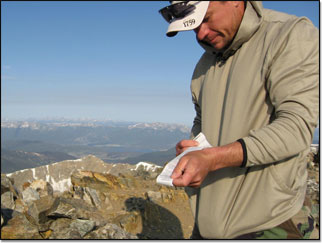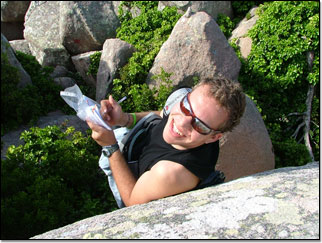Finding your First Geocache
Step 1 – Research
Your outdoor geocaching adventure starts indoors with preparation and online research. Search Geocaching.com for a geocache that will meet your immediate goals and interests. Are you looking for an adventure for the entire family? Perhaps an afternoon in a dog-friendly park? Make sure that you review the cache attributes since these icons serve as a helpful resource as you select your first geocache to find.
As you select a geocache, keep in mind the following:
- Have you considered the difficulty and terrain ratings of the cache? We suggest choosing a 1/1 difficulty and terrain rating for your first geocache find so that you can learn how geocaches are placed. Remember, geocaches are hidden but not buried.
- Consult the surrounding maps of the area. Is this an urban or rural cache and how will this change your preparation? Do you have the right maps to help support you in the cache search? Road maps may be more than adequate within a city but topographical maps, which show land and water features, may be more useful elsewhere. Topographical maps will tell you what terrain you will encounter.
- Keep in mind that distances can be deceiving. Understand the difference between distances as the crow flies (a direct line) versus true distance of travel. You may be a mile from the cache according to you GPS device, but there may be a river or other obstacles in the way. It is up to you to find the best route to the cache, remembering to respect the environment and practice Cache In Trash Out along the way.
- Once you are close to the cache location, you can navigate using your GPS device. For instance, if you are in a small park, you can try to simply follow the GPS arrow. In a large park, this method may be challenging so follow the established trails as much as possible while still keeping the GPS arrow heading the general direction of the cache location.
Our experience has shown that preparation and research will vary for each cache. Many people find that they begin with the online maps to get an idea of the area, and then decide to supplement with a detailed paper map. The cache page itself is a rich source of information and may include an encrypted hint. Previous finders may have uploaded photos, or may have included clues in their online log. Be careful though; too much information may inadvertently ruin the surprise for you.
Step 2 – Safety Tips
As with any outdoor activity, it is important to be prepared. Here are a few helpful tips:
- Make sure to tell someone where you are going and when you intend to return. Going into a forest or remote locations without a partner is inherently dangerous. Geocaching is great fun, so think about planning a group hike with your family or friends around the geocache adventure.
- Pay attention to your surroundings. It is easy to focus on your GPS device and forget to look around you. (Please believe us, there is a reason why this shirt is so successful.) Being conscious as to where you are walking will not only ensure your personal safety but will also respect the environment.
- Pack your pack. Bring along a compass, map and extra batteries in case your GPS device fails. No matter the terrain or length of time on the trail, it is always a good idea to set out with extra clothing, food and water.
- Be mindful of the local environment, especially during seasonal changes. Is the area prone to poison ivy or poison oak? What about bugs or dangerous animals? Not sure of the area in which you are heading? Ask a question in the regional geocaching forums. Local geocachers are happy to help support you.
Step 3 – The Hunt
Now you are ready to find your first geocache!
- As you leave your car or a well-marked trail, make sure to mark its location as a waypoint! It may sound silly, but once you get focused on the cache hunt, it’s easy to get disoriented. Use the waypoint to guide you in your safe return.
- It should be pretty straightforward to get within a mile or so of the cache location. If you have done your research well, you should also feel good about knowing the best method of getting to the cache location. We suggest that you keep your GPS device on the entire time even if you may occasionally lose signal from overhanging trees, mountains, large concrete structures, etc.
- When you get close to the geocache (within 300 feet, which is the length of a football field), check your GPS device’s signal strength. Sometimes the signal will have an error between 25 - 200 feet. Concentrate more on the overall distance decreasing and less on the arrow as you get closer to the final location.
- The final 30 - 100 feet can be the most difficult. It helps to think like the person who hid the cache. If there are stumps around, investigate around the base. Check for an unnatural pile of rocks. Some geocaches, especially in highly populated areas, are cleverly hidden with ingenious camouflage, so it helps to know something about the container used. Is it as bigger than a shoebox or small like a film canister?
Step 4 – The Actual Find

Hurray! You found your first geocache. Congratulations! Now what?
- Take note of the style and method of this hide. Where did this geocache bring you? Enjoy the location.
- Sign the logbook with your name, the date, and a few words about your experience.
- If you trade for items, remember to trade for something that is of equal or greater value.
- Make sure to seal the cache and place it back exactly where and how you found it. If it had some rocks covering it, please replace those.
- Use the waypoint you created as a helpful guide for your return.
- When you get home, log your experience online by going back to that cache page and using the links provided. The cache owner is automatically notified of your log and is always happy to know about your adventure, the condition of their cache, and any environmental factors. Upload photos to share your experience visually with other geocachers.
Still have questions? Please reference our Getting Started page or our Resources page for additional details.
Welcome to the exciting world of Geocaching!
Finding your First Geocache

.jpg)



